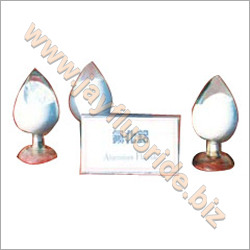Ammonium Fluoride
Product Details:
- Physical Form Powder
- Poisonous YES
- Storage Store in tightly closed containers in a cool, dry place, away from acids and moisture
- Solubility Soluble in water, slightly soluble in alcohol
- Smell Ammoniacal odor
- Product Type Inorganic Salt
- Density 1.01 Gram per cubic centimeter(g/cm3)
- Click to View more
Ammonium Fluoride Price And Quantity
- 50 Kilograms
- 220 INR/Kilograms
Ammonium Fluoride Product Specifications
- Powder
- YES
- Store in tightly closed containers in a cool, dry place, away from acids and moisture
- Industrial Grade
- Soluble in water, slightly soluble in alcohol
- Ammoniacal odor
- Inorganic Salt
- 1.01 Gram per cubic centimeter(g/cm3)
- 24 months if properly stored
- Used in etching, preservation of wood, manufacturing of chemicals
- 28263000
- Saline, pungent
- Crystalline
- 37.04 g/mol
- Acidic (pH < 7 in solution)
- Ammonium ions and fluoride ions
- NH4F
- Min 98%
- 100C
- White crystalline powder
- Glass etching, metal surface treatment, chemical reagent
Ammonium Fluoride Trade Information
- 100 Kilograms Per Day
- 1 Week
Product Description
We are considered to be one of the most primary manufacturers and suppliers of Ammonium Fluoride. This chemical is precisely formulated by our skilled professionals using superlative quality compounds. Our offered range of chemicals is highly appreciated for its properties like crystal structure, high melting point and pure & precise composition. Ammonium Fluoride offered by us is widely used in textile industry for printing and dying purposes.
Other names Neutral Fluoride- CAS number 12125-01-8
- EC number 235-185-9
- UN number 2505
- RTECS number BQ6300000
- MSDS ICSC 1223
- EU classification Toxic (T)
- EU Index 009-006-00-8
- R-phrases R23/24/25
- S-phrases (S1/2), S26, S45
- Flash point Non-flammable
Product Details:
| CAS number | 12125-01-8 |
| Structure | Crystal structure, Wurtzite structure (hexagonal) |
| EC number | 235-185-9 |
| UN number | 2505 |
| RTECS number | BQ6300000 |
| Molar mass | 37.037 g/mol |
| Appearance | White crystalline solid |
| Density | 1.01 g/cm3 |
| Melting point | Decomposes at elevated temperatures |
| Solubility in water | 45.3 g/100 ml (25 Degree C) |
| Physical State | Crystals |
| Usage | Laboratory |
| Molecular Formula | NH4F |
Chemical and Physical Properties
Ammonium fluoride is characterized by its white, crystalline appearance and a distinctive ammoniacal smell. It melts at 100C but decomposes before boiling, producing ammonia and hydrogen fluoride. Its density is 1.01 g/cm3 and it is acidic in water (pH < 7). The compound is highly soluble in water, making it suitable for various chemical applications.
Safe Storage and Handling
To ensure product stability and safety, ammonium fluoride should be stored in tightly closed containers, preferably HDPE bags or drums, in cool, dry areas. Avoid exposure to acids and moisture. During handling, it is crucial to wear protective gloves, clothing, and eye protection due to its toxic nature and capability to harm aquatic environments.
Major Applications and Usage
Industrially, ammonium fluoride is widely used for glass etching, metal surface treatments, wood preservation, and as a chemical reagent. Its high purity enhances its effectiveness across these applications, offering reliable results in manufacturing and laboratory processes. Benefits include precise etching, preservation, and improved chemical reactions.
FAQs of Ammonium Fluoride:
Q: How should ammonium fluoride be stored to maintain its stability?
A: Ammonium fluoride should be kept in tightly closed HDPE bags or drums, stored in a cool, dry location away from acids and moisture. This ensures stability and preserves its quality for up to 24 months.Q: What are the recommended precautions when handling ammonium fluoride?
A: It is vital to wear protective gloves, clothing, and eye and face protection to prevent contact and inhalation. Because it is toxic and can produce hazardous decomposition products such as ammonia and hydrogen fluoride, proper safety measures must be followed.Q: Where is ammonium fluoride commonly used in industry?
A: Industrially, ammonium fluoride is applied in glass etching, metal surface treatment, preservation of wood, and as a chemical reagent in manufacturing various chemicals.Q: When does ammonium fluoride decompose, and what does it release?
A: Ammonium fluoride begins to decompose before reaching its boiling point, releasing ammonia and hydrogen fluoride gases. These decomposition products necessitate adequate ventilation during processing.Q: What benefit does ammonium fluoride offer in glass etching and metal treatment?
A: Its high purity and solubility in water allow precise chemical reactions, making it highly effective for applications such as glass etching and enhancing the quality of metal surface treatments.Q: How does ammonium fluoride affect the environment?
A: Ammonium fluoride is toxic to aquatic life, so spills should be avoided and disposal should comply with environmental regulations to minimize ecological impact.
Price:
- 50
- 100
- 200
- 250
- 500
- 1000+
 |
JAYFLUORIDE PRIVATE LIMITED
All Rights Reserved.(Terms of Use) Developed and Managed by Infocom Network Private Limited. |







